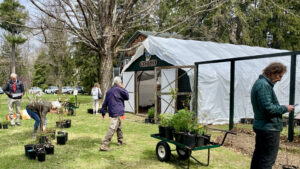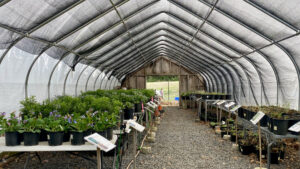
There’s always buzz on the first day of t he D&R Greenway’s native plant sale. Photo Credit: Carolyn Jones
This story was produced in collaboration with CivicStory as part of the Ecology Civics Reporting Project.
Facing habitat loss and declining biodiversity, a Princeton-based nursery helps gardeners restore New Jersey’s wild beauty, one seedling at a time.
Princeton, NJ — If Tina Notas seems attached to the plant you just bought at the native plant sale, it’s because she is. As director of land stewardship for the D&R Greenway Land Trust, she probably found the seed herself, tucked it in a paper bag, and carried it in her pocket or car. Maybe she sowed it in a germination box, or watched a volunteer master gardener do it. Together, they oversaw the slow alchemy of a speck becoming leaves. As seasons passed and roots lengthened, Notas and her team were already imagining the day you’d hold the plant in your hand.
These aren’t your ordinary seedlings from a big box store. Beyond being mostly hand-raised, the D&R Greenway’s nursery plants are native to New Jersey. With names like golden alexander, hairy beardtongue, and rattlesnake master, these diverse flora are largely sourced from nearby sites. Because they evolved within the local landscape, they provide exactly what native birds, bees, butterflies, and bats need to thrive. Their origins also make them more resilient to local climate conditions than plants shipped from afar.
The native plants nursery is central to the D&R Greenway Land Trust’s mission of conserving land for the future. The nonprofit has preserved more than 22,000 acres of New Jersey in perpetuity. With the help of D&R’s land stewards, these tracts are gradually returning to their natural ecological states. The nursery was founded in 2008 to generate natives grown from wild seeds for local restoration projects. Now, half the nursery’s stock is planted on D&R lands as part of its restoration efforts; the rest is sold to the public. By involving gardeners in the mission to return native flora to the landscape—and by selling the plants at fair prices—this Princeton-based land trust is adding diversity to local ecosystems, one homegrown seedling at a time.
That’s good news, because even in 2025, it’s still surprisingly tricky to find native plants. Thanks to the market dominance of a few large horticultural companies, it’s easier to buy a butterfly bush—a flashy import from East Asia with little value to local butterflies—than to find monarch-friendly milkweed. Despite rising awareness of fragile ecosystems, many gardeners still struggle to source the plants preferred by their local birds and bees.
Fortunately, innovators are filling the gap. Specialty societies, boutique outlets, and a growing number of online nurseries now offer native plants. But for gardeners who want to eyeball a plant before purchase—or ask for specific advice—it helps to find someone growing natives close to home.
For this reason, there’s always buzz on the first day of the D&R Greenway’s native plant sale. These spring and fall dates are eagerly written into gardeners’ calendars. Long before Notas and her team open the greenhouse doors, shoppers are already pacing the lawn outside.
During the recent April sale, the tables were covered with several varieties of native ferns and thirty types of wildflowers. Outside, next to the potting shed, customers moved carefully through stands of native trees, shrubs, and vines. Not everything was started at the D&R nursery, but all plants, even those brought in from outside nurseries, were native and pesticide-free.
As shoppers paused to consider an elderberry shrub or a buttonbush, master gardeners in green aprons moved through the crowd. They offered advice on plant care and selection. Their expertise—rooted in years of training through the Rutgers Master Gardener Program, followed by internships and hands-on experience—means they really know their onions. (Nodding onions, as it happens, were one of the wildflowers for sale this April.)
As a brisk wind rippled through the greenhouse, Sue Tarr, one of the master gardeners, helped shoppers with their choices. Tarr has volunteered at the D&R nursery for several years. She also co-founded a native plants nursery in Middlesex County as part of her training as a Rutgers Environmental Steward.
Tarr had sowed many of the seedlings on sale that day. Alongside other master gardeners, she used a process called cold moist stratification to mimic how seeds germinate in the wild. She has also grown many of those plants on her own property. That gives her the confidence to advise customers on how they’ll perform in their yards.
“I can give them the lived experience,” she said.
For many gardeners, that’s welcome advice. Some customers are still at the beginning of their journey, like Amanda Howard, who was making her second visit to a D&R plant sale. Browsing with her 18-month-old daughter in her arms, she chose blueberry bushes, arrowwood shrubs, and a pair of lanceleaf coreopsis after consulting the display notes.
Howard had driven from South Jersey for two reasons: she wanted to buy native plants in person, and, like last year, she planned to take a walk through nearby Greenway Meadows with her daughter afterward.
Another customer, Sharyn Magee, also had a plan. A birding expert who conducts bird surveys at local preserves, Magee comes to the D&R native plant sale every year to shop strategically. She looks for berrying and fruiting plants that will feed summer bird residents on her property as well as migrants in the fall.
Pointing to a spicebush at her feet, Magee explained that its berries have a high lipid content—essential for fueling long-distance migrations. “The peak thrush migration occurs when the berries are on the spicebush,” she said. “They co-evolved.” She also picked out highbush blueberries for early berries, and winterberry holly for later in the season.
“Bird populations are plummeting because insect populations are plummeting—because native plants are disappearing,” she said.

On sale are ferns, wildflowers, trees, shrubs, and vines. All plants are native and pesticide-free. Photo credit: Carolyn Jones
As a stream of customers exited the greenhouse with gallon pots tucked under their arms, Notas moved through the check-out line like a pollinating bee. She had caught the gardening bug early, having attended the Governor’s School on the Environment as a high schooler and then going on to study at the College of Environmental Science and Forestry at the State University of New York. After college, she worked at Drew University where she developed native plant zones. Notes has been with the D&R Greenway Land Trust for six years now, which means at the April sale, she had a greeting and a smile for every gardener, most of whom she recognized. Customers ranged from private landowners on large properties to everyday gardeners with modest lots. Notas is thrilled to see them all.
Not only are their purchasing choices furthering the mission of the D&R Greenway Land Trust, she said, but Notas is excited to think about their gardening adventures ahead. She recalls when she first planted a single swamp milkweed with her own daughter, and by the second year, she had monarch butterflies in her yard.
“It’s magical to see it happen,” she said. “We have over two thousand beautiful native plants in New Jersey, so there’s an opportunity to fall in love with many varieties. I’m excited that this nursery can provide a source for our community”
Even better, if the gloomy early spring caused anyone to delay putting on their gardening boots, there’s sunny news ahead. Notes is offering a mid-spring sale. On May 2 and 9 from noon onwards, green thumbs can gather at the D&R Greenway’s native plants nursery at 1 Preservation Place in Princeton. Flowers such as swamp milkweed and pawpaw will be on sale. Customers, or as Notes calls them, ‘supporters of the cause’, can be assured: every one of their purchases will contribute to New Jersey’s native plants revival.
This story was produced in collaboration with CivicStory as part of the Ecology Civics Reporting Project.
Co-published with TAPinto Princeton.

Carolyn Jones is a 2025 Ecology-Civics fellow and a freelance reporter based in Princeton.
